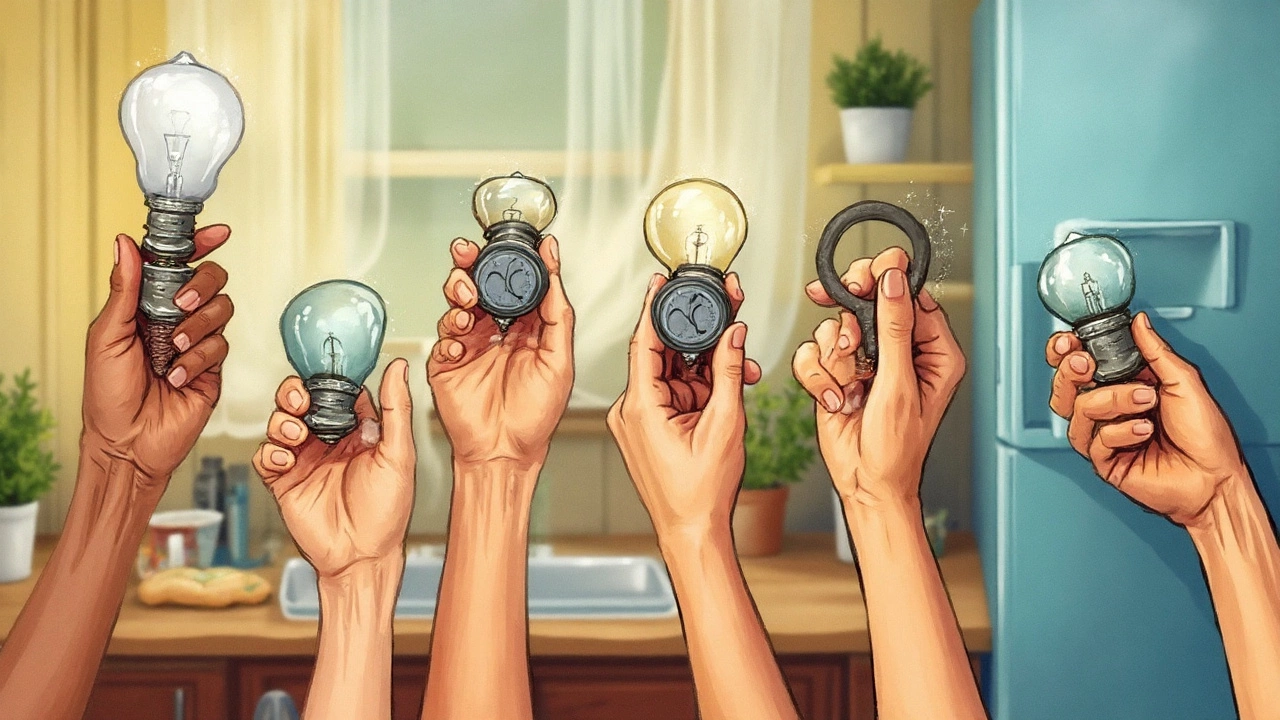If you’ve heard a weird clunk from the fridge, opened the door to warm milk, or had your leftovers spoiled overnight, you’ve probably had the same thought as me: ‘Can I actually fix this fridge myself?’ Right now, millions of refrigerators are humming—or grumbling—in kitchens everywhere, but did you know that 60% of fridge failures are due to surprisingly basic problems? I’ve found myself standing in front of my own fridge (Charlie waiting for cold cheese, Luna pretending to care) and wondering if I should reach for my toolbox or my phone. That’s the real-life fridge saga—most of us really want to save money and skip the hassle of a service call, but is it safe to go poking around? It turns out, most modern fridges last an average of about 13 years, but almost half will need some type of fix along the way. The real surprise: you can actually do a lot more than you might think, as long as you know what you’re up against, and you don’t mind getting a little chilly in the process.
What You Can Fix: Common Fridge Problems and Easy DIY Solutions
First things first—before you grab your screwdriver and a flashlight, let’s separate the DIY-friendly issues from the ones that need a technician. The good news? A good chunk of refrigerator woes are “user serviceable.” About 1 in 3 homeowners who try to fix their own fridge succeed, especially with simple stuff. Let’s walk through popular DIY fixes.
Power problems top the list. Fridge not running at all? Often, this is just a tripped breaker or a loose plug. Don’t laugh—happens more often than people admit. So first: check the outlet, make sure the fridge is plugged in, and reset the breaker. Still no dice? Try plugging another device in to see if the outlet works. If the outlet is dead, that’s an electrical issue, but if the outlet is fine and the fridge is unresponsive, then the problem could be more involved.
Let’s talk about a fridge that’s running but not cooling well. The most common culprit is dirty condenser coils—those things that usually live under or behind your fridge, gathering all sorts of gunk. Over time, they clog with dust, pet hair (Charlie’s fault, not mine), and kitchen grime. Grab a coil brush and a vacuum, unplug the fridge, and gently clean the coils. According to manufacturers, cleaning the coils once or twice a year can improve efficiency by up to 30%.
Food freezing in the fridge section? Check the temperature dial—sometimes, people turn it up by accident. You also want to check the damper, the little hatch that controls cold air flow between fridge and freezer. If it’s stuck open, cold air floods the fridge. Most manual dampers can be unstuck with a clean finger (wash your hands first—trust me, no one wants fingerprints on their yogurt).
Ever found a puddle around your fridge? Water leaks usually come from two spots: a blocked defrost drain or a cracked water line (if you have an ice maker or water dispenser). An easy DIY? Find the drain hole at the back of your fridge’s interior and clear it with hot water and a turkey baster. For water lines, check for obvious cracks—most lines snap in place and you can buy replacements at a hardware store.
If the fridge is noisy or rattling, check for loose shelves or items vibrating against each other. But also check that the fridge is level. Adjust the legs underneath until it stands solidly on the floor. A fridge sitting lopsided can hum, buzz, rattle, or even leak.
Light not coming on when you open the door? Fridge light bulbs are easy and cost just a few bucks to swap out. Just remember to unplug your fridge before playing around in there. If the light still won’t turn on, it’s probably the door switch—you can find replacements online with a little research, matching your model number and following a quick video.
So much of what goes wrong with fridges are little things that look major. If your fridge is icing up in the freezer, check the door gasket for tears or dirt. A bad seal lets hot air sneak in, making the fridge work overtime. Clean the gasket with warm soapy water and check for cracks. If it’s warped or broken, you can order a new one (measure carefully first) and install it yourself.
There’s even more. Check the list:
- Wobbly shelves? Most just snap in—push them back into their fittings.
- Strange odors? Remove everything, clean with baking soda, and put an open box inside for freshness.
- Ice maker stuck? Check for jammed cubes or clogged water filters.
- Control panel not working? Reset the fridge by unplugging for five minutes—sometimes electronics just need a hard reboot.
All these steps are very doable for anyone with a little patience and willingness to get their hands cold. Fixing your fridge yourself can save you $100 to $300 per service call, and you get bragging rights, too.

When to Call for Help: Avoiding Costly and Dangerous Mistakes
Not all fridge fixes are created equal, and some are definitely not DIY territory. So where’s the line? If you detect a chemical smell, see a pool of oily liquid, or if your fridge compressor is loudly clicking or completely silent (with no cooling), step back. Compressor repairs, sealed system work (like refrigerant leaks), and anything involving the electronics or motherboard are out of the safe zone for most folks. The gases and pressurized systems in modern refrigerators are not only tricky, but also dangerous if you don’t know what you’re doing. In fact, UK law (and in lots of other places) says you need to be certified to handle fridge refrigerant, so don’t mess around.
If your fridge is still running but frost is taking over everywhere—think ‘snowstorm in the freezer’—you might have a faulty defrost timer, thermostat, or heater. These are still fixable, but require some skill with a multimeter and a willingness to unscrew panels and test for voltage (unplug before you start, always). If you’re not comfortable checking live circuits or you don’t have tools, that’s a sign to call in a pro.
There’s a rule of thumb appliance repairmen use: if your fridge is over 10 years old and the fix will cost more than half the price of a new one, consider replacing instead of repairing. According to Consumer Reports, new fridges run £400 to £1,000 for a basic to mid-range model. Out-of-warranty compressor replacements can cost £250 to £600, making a new purchase a smarter choice.
Here’s a quick breakdown of ‘DIY’ vs ‘call a pro’ jobs:
| Problem | DIY | Call a Pro |
|---|---|---|
| Dirty coils | ✔ | |
| Clogged drain | ✔ | |
| Faulty door gasket | ✔ | |
| Damaged compressor | ✔ | |
| Refrigerant leak | ✔ | |
| Electronics/control board | ✔ | |
| Fan replacement | Maybe, with the right tools | ✔ |
If it’s not something you can easily reach, remove, and replace without special gear, don’t risk it. On top of that, DIY work on sealed system components can void your fridge warranty. Always check your warranty status before digging in, because some brands actually send a tech for free if it’s under five years old. And if you try to fix a problem that involves the coolant or electronics by yourself, you might just turn a £100 repair into a £1,000 disaster.
One personal note here: a friend of mine once tried to solder a cracked evaporator line. He ended up calling the fire brigade, got a kitchen full of fumes, and had to bin the whole fridge. It’s honestly not worth the risk, especially with anything you can’t easily see or unscrew.
You might hear stories of folks who fixed compressor relays, swapped out fan motors, or even did their own defrost heater swaps. While it’s technically possible if you have strong electrical skills, most home DIYers end up frustrated. If you’re confident, and you have solid tutorials (YouTube is loaded with them), you might give a go—but if you hear “click, buzz, silence,” just close that panel and call your local repair team. Your future self will thank you.

Tips, Tools, and How to Save (or Waste) Your Time and Money
A handy DIY fridge repair isn’t about knowing all the secrets—it’s about having the right mindset, information, and tools before you start. The single most powerful tool you can have? Your fridge’s model number. It’s usually on a sticker inside the main compartment or hidden in the freezer. Write it down before you start searching for replacement parts or watching repair tutorials. Without this, you’re basically guessing in the dark.
Here’s what every fridge fixer should have on hand:
- Multibit screwdriver set (fridges are full of screws—none of them match)
- Flashlight or work light (for seeing behind and underneath)
- Vacuum cleaner with a hose attachment and coil brush
- Old towel (for water leaks or cleaning up spills)
- Turkey baster (weirdly useful for clearing drain tubes)
- Gloves—especially if working near sharp metal edges or with weird goo
- Camera or phone for photographing before you unplug connections
One life-saving trick: always unplug the fridge before doing anything inside or behind it, unless you specifically need to test live voltage (and if you do, double-check your steps). Want to swap a bulb or fix a loose shelf? Fine. Anything to do with wires or fans? Disconnect first. Every year, thousands of home DIYers end up with electrical shocks just from forgetting this step.
Another thing most people miss: defrost cycles run every 8-12 hours in most modern fridges. If your fridge is “not cooling” but you just loaded in a ton of hot food, it could be in defrost mode and will recover by itself. Give it a few hours and keep the doors closed.
If you’re trying to diagnose temperature issues, use a cheap fridge thermometer. Set it in both the fridge and the freezer, wait an hour, and check the stats. Fridge should be about 37°F (3°C), freezer around 0°F (-18°C). Higher than this? Try adjusting the thermostat dial one notch at a time. It’s slow—modern fridges can take up to 24 hours to stabilise after an adjustment.
If you ever order parts online, triple-check the part number and model. Fridge manufacturers love making tiny changes between models, and one 5p gasket can mean your new part almost fits, but doesn’t seal or latch. Reputable UK websites will let you search by model—a huge time saver.
When you’re cleaning, avoid using harsh chemicals in or around the fridge. Hot soapy water does the job perfectly, and baking soda neutralises bad smells without risk. Manufactures warn against cleaning coils or plastic shelves with bleach or ammonia—they can degrade rubber seals and flimsy insulation foam.
One data point: about 45% of “broken” fridges just have minor issues like blocked vents, frozen coils (usually from the doors being left open), or false alarms from overpacked shelves. Spreading out your food and not blocking vents can actually boost fridge performance overnight.
If you’re feeling lost, most fridge brands now offer PDF manuals online—even for older models. It’s worth a five-minute search, because they often have troubleshooting charts you can follow without staring at random forums.
And don’t underestimate how much you can learn by peeking inside your fridge’s compartments. A quick visual check—are fans spinning? Is there frost on the back wall? Is there water pooling on the bottom?—can tell you more than any blinking light on the lever. Use your senses, listen for odd noises, sniff for leaks, and feel for hot or cold spots. The more familiar you get with your own fridge, the less likely you’ll panic the next time something goes wrong.
So, can you fix a fridge by yourself? If you’re willing to learn, pay attention, and don’t overreach, yes—you can handle way more than you think. The first time you fix a noisy fan or clear a clogged drain, you’ll feel like a certified kitchen hero. Just know when to call it—your fridge (and your future groceries) will thank you.


